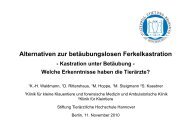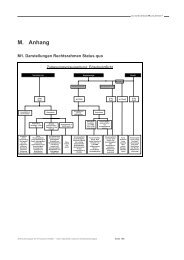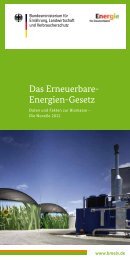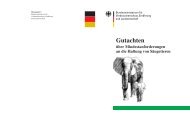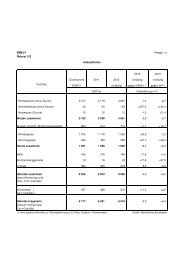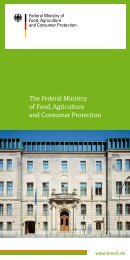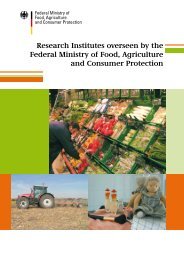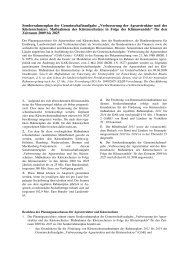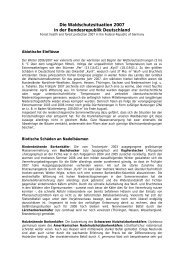German forests - Nature and economic factor - BMELV
German forests - Nature and economic factor - BMELV
German forests - Nature and economic factor - BMELV
You also want an ePaper? Increase the reach of your titles
YUMPU automatically turns print PDFs into web optimized ePapers that Google loves.
Federal Ministry of<br />
Food, Agriculture<br />
<strong>and</strong> Consumer Protection<br />
<strong>German</strong> <strong>forests</strong><br />
<strong>Nature</strong> <strong>and</strong> <strong>economic</strong> <strong>factor</strong>
Contents<br />
<strong>German</strong> <strong>forests</strong> – <strong>Nature</strong> <strong>and</strong> <strong>economic</strong> <strong>factor</strong> 4<br />
One third of <strong>German</strong>y covered with <strong>forests</strong> 4<br />
Forests are natural habitats 4<br />
Who owns the <strong>forests</strong>? 7<br />
Forestry groupings 8<br />
Right of access for everyone 9<br />
Forests are facing multiple stress <strong>factor</strong>s 10<br />
Forestry – Responsibility for many generations 12<br />
Prime principle: Sustainability 12<br />
Close-to-nature forest management 13<br />
Silviculture makes it possible 14<br />
Promotion of species diversity 16<br />
Forests in protected areas 17<br />
Forest – based industry in <strong>German</strong>y 18<br />
Forest <strong>and</strong> game 22<br />
Hunting district system 22<br />
Wildlife management requirement 23<br />
Forest policy: Balance between<br />
different interests 24<br />
Support schemes for forestry 25<br />
Forests around the globe: international<br />
cooperation is required 27<br />
3
<strong>German</strong> <strong>forests</strong> –<br />
<strong>Nature</strong> <strong>and</strong> <strong>economic</strong> <strong>factor</strong><br />
One third of <strong>German</strong>y covered with <strong>forests</strong><br />
<strong>German</strong>y ranks among the densely wooded countries in<br />
Europe. Around 11 million hectares corresponding to one<br />
third of the national territory are covered with <strong>forests</strong>.<br />
In regional terms, the proportion of woodl<strong>and</strong> cover varies<br />
widely, ranging from 10 % in Schleswig-Holstein to over<br />
40 % in Rhinel<strong>and</strong>-Palatinate <strong>and</strong> Hesse, the most thickly<br />
wooded Länder (federal states).<br />
Forests increased by approx. 1 million hectares in <strong>German</strong>y<br />
over the past four decades. The percentage of over 80-year<br />
old st<strong>and</strong>s also rose from one quarter to one third of the<br />
forest area. The timber stocks in <strong>German</strong>y account for<br />
320 m 3 per hectare, with the annual timber increment totalling<br />
around 100 million m 3 in accessible forest without logging<br />
restrictions in the mainst<strong>and</strong> today, i.e. around<br />
9.5 m 3 /ha. Hence, <strong>German</strong>y occupies a leading place compared<br />
with other European countries. This is largely a result<br />
of the efforts to rebuild high-yielding <strong>and</strong> ecologically<br />
valuable <strong>forests</strong> after the destruction of large forest tracts<br />
over the past centuries <strong>and</strong>, more recently, after the<br />
clear-cuttings due to both World Wars.<br />
Forests are natural habitats<br />
Today‘s distribution of <strong>forests</strong>, farmed agricultural areas,<br />
traffic spaces <strong>and</strong> settlement areas in <strong>German</strong>y is the result<br />
of human interventions over many centuries. The remaining<br />
<strong>forests</strong> are no longer primeval <strong>forests</strong>, but production<br />
<strong>forests</strong> shaped by humans. As a potentially natural vegetation<br />
form, beech forest communities would prevail in<br />
<strong>German</strong> <strong>forests</strong> <strong>and</strong> cover around 74 % of the forest area.<br />
4
Oak forest communities represent the second largest group<br />
of natural forest communities <strong>and</strong> would account for 18 % of<br />
the forest area.<br />
The historical development of forestry explains why <strong>German</strong><br />
<strong>forests</strong> are today composed of 60 % coniferous <strong>forests</strong> <strong>and</strong><br />
around 40 % deciduous <strong>forests</strong>. In the past few decades,<br />
more importance had been attached to regeneration with<br />
site-adapted tree species. The efforts to shape the composition<br />
of forest tree species in a more semi-natural way have<br />
been crowned with success. Approx. 73 % of <strong>German</strong> <strong>forests</strong><br />
nowadays consist of mixed st<strong>and</strong>s. Spruce accounts for the<br />
largest share among the tree species (28 %), followed by pine<br />
(23 %), beech trees (15 %) <strong>and</strong> oak trees (10 %).<br />
5
23.3 % Pine<br />
6.0 % Other coniferous trees<br />
9.6 % Oak<br />
14.8 % Beech<br />
15.7 % Other deciduous trees<br />
2.4 % Areas whithout trees<br />
28.2 % Spruce<br />
Diagram 1: Tree species distribution in <strong>German</strong>y (Second National Forest<br />
Inventory 2002)<br />
The tree species proportions vary <strong>and</strong> depend on the<br />
specific natural features <strong>and</strong> site conditions as well as on<br />
different historic developments. Large-scale forest zones<br />
can be found in <strong>German</strong>y: pine trees abound in the north<br />
of <strong>German</strong>y, deciduous trees prevail in the lower mountain<br />
ranges <strong>and</strong> coastal areas <strong>and</strong> southern <strong>German</strong>y is rich in<br />
spruce trees.<br />
6
Who owns the <strong>forests</strong>?<br />
The Federal Republic of <strong>German</strong>y is a federal state. Responsibility<br />
for the <strong>forests</strong> thus mainly lies with the Länder.<br />
While the Federal Government merely sets the forest policy<br />
framework, the Länder are responsible for the formulation<br />
<strong>and</strong> implementation of concrete forest policy targets.<br />
Private persons, corporate entities (notably municipalities)<br />
<strong>and</strong> the state, i.e. mainly the Länder, own woodl<strong>and</strong>s. Private<br />
forest undertakings own an average forest area size of 5 hectares<br />
that is frequently spread over several smaller areas.<br />
7<br />
44.0 % Private <strong>forests</strong><br />
20.0 % Communal <strong>and</strong> other<br />
<strong>forests</strong><br />
3.0 % Forests of the escrow<br />
company<br />
30.0 % State <strong>forests</strong> (Länder)<br />
3.0 % State <strong>forests</strong><br />
(Federal Government)<br />
Diagramm 2: Types of ownerships (Second National Forest Inventory 2002)
The communal <strong>and</strong> other corporate body <strong>forests</strong> are clearly<br />
larger. The undertakings with less than 20 hectares <strong>forests</strong><br />
represent 57 % of the privately owned forest area.<br />
The largest undertakings in terms of woodl<strong>and</strong> cover are<br />
owned by the state. A state forest undertaking manages between<br />
8,000 <strong>and</strong> 15,000 hectares <strong>and</strong> mostly also performs<br />
stewardship tasks for private <strong>and</strong> municipal <strong>forests</strong>. The<br />
Federal Government currently owns around 410,000 hectares.<br />
These are predominantly <strong>forests</strong> intended for military<br />
purposes.<br />
Proportion of woodl<strong>and</strong> areas in the Länder (in %)<br />
Baden-Württemberg 38<br />
Bavaria 36<br />
Br<strong>and</strong>enburg <strong>and</strong> Berlin 35<br />
Hesse 42<br />
Mecklenburg-Western Pomerania 23<br />
Lower Saxony, Hamburg <strong>and</strong> Bremen 24<br />
North Rhine-Westphalia 26<br />
Rhinel<strong>and</strong>-Palatinate 42<br />
Saarl<strong>and</strong> 38<br />
Saxony 28<br />
Saxony-Anhalt 24<br />
Schleswig-Holstein 10<br />
Thuringia 32<br />
<strong>German</strong>y as a whole 31<br />
Table 1: Share of <strong>forests</strong> in the Länder (Second National Forest Inventory 2002)<br />
Forestry groupings<br />
Many forest owners in <strong>German</strong>y only own small <strong>and</strong> fragmented<br />
<strong>forests</strong> that are hard to manage. As self-help organisations,<br />
forestry groupings are designed to improve the<br />
8
<strong>economic</strong> situation of these undertakings. The forest operations<br />
can be conducted as a joint service. This encompasses,<br />
inter alia, the harvesting of wood <strong>and</strong> other forest products,<br />
the planting <strong>and</strong> tending of forest crops, silvicultural treatment<br />
operations as well as the construction <strong>and</strong> maintenance<br />
of forest roads. In addition, forest products can be<br />
jointly marketed or machines purchased for joint use.<br />
Such types of cooperation have already existed since the<br />
mid-19 th century. In 1969, the groupings were placed on a<br />
uniform legal basis. In <strong>German</strong>y, there are currently around<br />
4,300 forestry groupings with more than 400,000 members<br />
who together own 3.8 million hectares of <strong>forests</strong>. This corresponds<br />
to more than one third of <strong>German</strong>y’s forest area.<br />
Right of access for everyone<br />
In <strong>German</strong>y, anybody can enter <strong>forests</strong> for recreational<br />
purposes at any time <strong>and</strong> anywhere. It is a right to which citizens<br />
are entitled, but also commits them to act responsibly<br />
towards the forest owner, nature <strong>and</strong> other people who take<br />
a rest in <strong>forests</strong>. Forest <strong>and</strong> nature conservation legislation<br />
contains restrictions <strong>and</strong> requirements for forest visitors,<br />
e.g. ban on access to certain areas, ban on smoking <strong>and</strong> open<br />
fire <strong>and</strong> straying from roads, keeping dogs on a lead <strong>and</strong> the<br />
protection of trees, timber <strong>and</strong> forestry or hunting facilities.<br />
9
Forests are facing multiple stress <strong>factor</strong>s<br />
Forests are particularly exposed to abiotic <strong>and</strong> biotic hazards.<br />
Abiotic hazards include gale-force winds, fire, snow,<br />
ice <strong>and</strong> frost. In <strong>German</strong>y, storms are of prime importance.<br />
They can frequently wreak catastrophic damage. As the<br />
table below indicates, heavy storms have accumulated during<br />
the last decades, challenging forestry as well as timber<br />
markets. Only preventive silvicultural operations can help<br />
against windthrow or damage from storm. This includes a<br />
site-adapted choice of tree species, a suitable st<strong>and</strong> structure<br />
as well as stable forest edges.<br />
Year Volume (mio. m3 )<br />
1967 13<br />
1972 17<br />
1975 2<br />
1984 9<br />
1990 75<br />
1993 2<br />
1999 35<br />
2007 37<br />
2008 5<br />
2010 up to 6<br />
Table 2: Forest storm damage in <strong>German</strong>y<br />
While forest fires occur frequently in <strong>German</strong>y, they only<br />
rarely develop into extensive blazes. The main cause is arson<br />
<strong>and</strong> human negligence. Particularly at risk are the pine-rich<br />
st<strong>and</strong>s in the northern <strong>and</strong> eastern Länder. Forest fires do not<br />
play a major role nationwide.<br />
Damage caused by insects ranks first among the biotic<br />
hazards. Pure st<strong>and</strong>s of spruce or pine covering large areas<br />
10
are particularly susceptible to damage by insects. Natural<br />
oak <strong>forests</strong>, too, can sustain serious damage due to insects.<br />
The so-called new types of forest damage have been observed<br />
since the mid-70s. Air pollution causes transformations in<br />
tree canopies <strong>and</strong> notably also damage to forest soils. The<br />
substance inputs in forest st<strong>and</strong>s clearly exceed the inputs in<br />
open ground <strong>and</strong> mostly surpass the critical levels for nitrogen<br />
<strong>and</strong> acid inputs. A large part of forest soils in <strong>German</strong>y<br />
shows, inter alia, marked acidification <strong>and</strong> base deficiency.<br />
New types of forest damage in <strong>German</strong>y<br />
Year Defoliation<br />
class 0<br />
(without<br />
damage)<br />
Table 3: New types of forest damage in <strong>German</strong>y (National Forest Inventory)<br />
11<br />
All tree species (%)<br />
Defoliation<br />
class 1<br />
(warning<br />
stage)<br />
Defoliation<br />
classes 2 – 4<br />
(visible<br />
damage)<br />
1996 39 39 22<br />
1997 37 41 22<br />
1998 38 41 21<br />
1999 37 41 22<br />
2000 35 42 23<br />
2001 36 42 22<br />
2002 35 44 21<br />
2003 31 46 23<br />
2004 28 41 31<br />
2005 29 42 29<br />
2006 32 40 28<br />
2007 30 45 25<br />
2008 31 43 26<br />
2009 36 37 27<br />
2010 38 39 23
Forestry – Responsibility for many<br />
generations<br />
While <strong>German</strong>y is generally a country poor in raw materials,<br />
it disposes of the largest total growing stock of timber in<br />
Europe at ca. 3.4 billion m 3 which is still increasing.<br />
In view of the short supply of fossil resources from crisisridden<br />
regions of the world, forest utilisation in <strong>German</strong>y<br />
makes an important contribution to securing the future of<br />
the country. Timber is also a valuable domestic source of<br />
energy that is enjoying an unexpected revival in the face<br />
of the increase in energy prices <strong>and</strong> increasing dem<strong>and</strong> for<br />
CO 2 -neutral raw materials.<br />
In addition, <strong>forests</strong> render services of general interest by<br />
performing protective <strong>and</strong> recreational functions. They<br />
play a key role in a densely populated industrialised country<br />
like <strong>German</strong>y with 230 inhabitants/km 2 .<br />
Prime principle: Sustainability<br />
Large production periods, extensive management over<br />
large areas, the dependence on natural site conditions<br />
such as soil <strong>and</strong> climate as well the interference of natural<br />
phenomena, e.g. storms, snowbreakage <strong>and</strong> ice-break, are<br />
features which essentially distinguish forestry from other<br />
lines of production. However, the paramount feature is the<br />
principle of sustainability that had already been introduced<br />
many centuries ago, i.e. to secure the diverse services<br />
rendered by <strong>forests</strong> for the benefit of the current <strong>and</strong> future<br />
generations on a permanent basis <strong>and</strong> in the best possible<br />
way.<br />
12
Close-to-nature forest management<br />
Close-to-nature forest management uses natural processes<br />
to develop both ecologically <strong>and</strong> <strong>economic</strong>ally valuable<br />
<strong>forests</strong>. Forest management in <strong>German</strong>y virtually dispenses<br />
with pesticides <strong>and</strong> fertilizers. According to studies, there<br />
are only minor differences regarding species diversity<br />
between ecologically compatible mixed forest management<br />
<strong>and</strong> unmanaged natural <strong>forests</strong>.<br />
Bigger game animals (roe deer, red deer, fallow deer <strong>and</strong><br />
wild boar) still have secure habitats in spite of <strong>German</strong>y being<br />
densely populated. In addition, forest ecosystems offer<br />
life opportunities for a large number of other animal species,<br />
notably also rare bird species, bats, amphibians <strong>and</strong><br />
reptiles. Many insect species <strong>and</strong> soil organisms encounter<br />
living conditions there that have become rare outside of<br />
<strong>forests</strong> due to intensive human exploitation. Moreover,<br />
<strong>forests</strong> provide a large number of endangered plant species<br />
with a basis for their existence. This holds true especially for<br />
those species that require more nutrient-deficient sites that<br />
have not been impaired by mineral fertilisation.<br />
13
Silviculture makes it possible<br />
The task of <strong>German</strong> silviculture consists in shaping <strong>forests</strong><br />
in such a way that timber is being efficiently produced, that<br />
the biological productive base of <strong>forests</strong> is being maintained<br />
<strong>and</strong> improved <strong>and</strong> that the services rendered by <strong>forests</strong><br />
remain usable by humans in a sustainable manner. The multitude<br />
of objectives of silvicultural management – depending<br />
on the respective site – has resulted in a multitude of<br />
silvicultural operations, that is in differentiated treatment<br />
<strong>and</strong> regeneration methods.<br />
The following principles are generally pursued today:<br />
ó conserving <strong>and</strong> establishing structurally diverse <strong>and</strong><br />
close-to-nature mixed <strong>forests</strong>,<br />
ó planting of site-adapted <strong>and</strong> stable tree species <strong>and</strong><br />
provenances,<br />
ó utilisation of natural regeneration where soil <strong>and</strong><br />
previous st<strong>and</strong> allow it,<br />
ó largely dispensing with clear-cuttings,<br />
ó multi-storied forest structure, if possible, to make<br />
maximum use of soil <strong>and</strong> air space,<br />
ó adapting the intensity of silvicultural treatment to<br />
individual st<strong>and</strong>s,<br />
ó st<strong>and</strong>-conserving wood harvesting,<br />
ó maintaining soil fertility <strong>and</strong> increasing it, if possible,<br />
ó using foreign tree species only after having examined the<br />
beneficial effect of their use in ecological <strong>and</strong> <strong>economic</strong><br />
terms.<br />
The aim is to implement close-to-nature forest management<br />
throughout <strong>German</strong>y. This objective has in <strong>German</strong>y already<br />
generated an increasing proportion of structurally diverse<br />
mixed st<strong>and</strong>s, long regeneration periods <strong>and</strong> natural rejuvenation<br />
methods. Forest management largely dispenses with<br />
clear-cuttings.<br />
14
High forest management is the predominant silvicultural<br />
system in <strong>German</strong>y. The st<strong>and</strong>s are either naturally or artificially<br />
regenerated at the end of a long production period<br />
(80 to 300 years depending on the tree species). Plenter<br />
<strong>forests</strong> (variable/multi-aged <strong>forests</strong>) constitute a type of<br />
forest that is close to nature. Here, trees of different age<br />
classes st<strong>and</strong> side by side. Regeneration takes place here<br />
on a continuous basis, more or less. Selective cutting use or<br />
group-selection cutting are carried out in plenter <strong>forests</strong>.<br />
Natural regeneration can develop or already existing regeneration<br />
can be used in the spaces opened up by cutting. The<br />
“plenter idea” with forest management by individual trees<br />
(single-stem working) <strong>and</strong> multi-storied forest structure<br />
has had a stimulating effect on many other silvicultural<br />
methods over many decades.<br />
Coppice <strong>forests</strong> <strong>and</strong> coppice-with-st<strong>and</strong>ards <strong>forests</strong> are rare<br />
today, but they are interesting in historical as well as in ecological<br />
terms. They are, inter alia, based on a regeneration<br />
of st<strong>and</strong>s at intervals of a few decades by means of coppice<br />
shoots <strong>and</strong> root suckers. As far as the appearance of st<strong>and</strong>s<br />
is concerned, these coppice st<strong>and</strong>s <strong>and</strong> coppice-with-st<strong>and</strong>ards<br />
st<strong>and</strong>s clearly differ from high <strong>forests</strong>. This type of<br />
management was widespread in the Middle Ages in particular<br />
<strong>and</strong> served to cover the requirements of tanning wood<br />
<strong>and</strong> fuel wood.<br />
15
Promotion of species diversity<br />
The incidence of rare flora <strong>and</strong> fauna is also fostered by<br />
targeted measures or omissions such as<br />
ó the establishment, tending <strong>and</strong> conservation of closeto-nature<br />
forest edges,<br />
ó leaving deadwood in <strong>forests</strong>,<br />
ó the conservation <strong>and</strong> upkeep of special biotopes in<br />
<strong>forests</strong>, e.g. wetl<strong>and</strong>s, heathl<strong>and</strong> <strong>and</strong> xeric grassl<strong>and</strong>,<br />
ó the protection of certain species such as red ants, bats,<br />
birds or orchids,<br />
ó the targeted conservation, stewardship or repeated<br />
planting of rarer tree species such as forest fruiting trees,<br />
common yew or chequer trees als well as through<br />
ó the maintenance of historical types of forest use such as<br />
coppice <strong>forests</strong> <strong>and</strong> coppice-with-st<strong>and</strong>ards <strong>forests</strong>.<br />
16
Forests in protected areas<br />
The protection of <strong>forests</strong> also plays a key role in a densely<br />
populated country like <strong>German</strong>y. The first nature conservation<br />
area in <strong>German</strong>y had already been established in 1836.<br />
In the subsequent decades, a diversified protected area system<br />
evolved in <strong>German</strong>y <strong>and</strong> proved its worth. According to<br />
the MCPFE 1 Assessment Guidelines for protected <strong>and</strong> protective<br />
forest <strong>and</strong> other wooded l<strong>and</strong> in Europe, the different<br />
protected areas can be divided into three broad categories:<br />
ó According to NFI 2 around 0.9 % of <strong>German</strong>y’s forest areas<br />
have been placed under absolute protection where no<br />
harvesting or other interventions are conducted. Following<br />
the National Biodiversity Strategy, this percentage is<br />
planned to increase up to 5 % within the years to come.<br />
ó On approx. 25 % of <strong>German</strong>y’s forest area, biodiversity<br />
functions take precedence over forestry operations. Silvicultural<br />
activities in protected areas of this category are<br />
targeted at a positive impact on the protection objectives.<br />
In some Länder, the percentage of these protected areas<br />
ranges between 30 <strong>and</strong> 40 % of the respective total forest<br />
area. Among this, 17 % of the forest area are covered by the<br />
EU protected area network “Natura 2000” (EU’s birds directive<br />
<strong>and</strong> habitat directive).<br />
ó 57 % of <strong>forests</strong> in <strong>German</strong>y have been designated as protected<br />
areas, where priority is given to the recreational<br />
function of <strong>forests</strong> as well as to the overall productive <strong>and</strong><br />
functional capacities of the natural environment.<br />
It has to be noted at this point that areal overlaps with the<br />
above described protection category occur but can not be<br />
avoided nor estimated. In addition, many forest areas in <strong>German</strong>y<br />
also exercise functions protected by law, e.g. as water<br />
protection <strong>and</strong> erosion control areas.<br />
1) MCPFE: Ministerial Conference on the Protection of Forests in Europe<br />
2) NFI: Second National Forest Inventory 2002<br />
17
Forest-based industry in <strong>German</strong>y<br />
According to current surveys, the forest- <strong>and</strong> timber industry,<br />
including processing <strong>and</strong> paper as well as printing <strong>and</strong> publishing,<br />
comprise nearly 1.3 million jobs with an annual turnover of about<br />
170 billion €. The turnover of the forest industry amounts to 5 billion<br />
Euro. Thus, the forest-based sector does not lag far behind other<br />
major <strong>economic</strong> sectors in <strong>German</strong>y in terms of turnover <strong>and</strong> jobs<br />
(the steel sector attained 26 billion Euro <strong>and</strong> the mining sector<br />
14 billion Euro). The socio-<strong>economic</strong> importance of forestry <strong>and</strong> the<br />
wood-based industry in <strong>German</strong>y has so far been seriously underrated<br />
by business <strong>and</strong> scientific communities <strong>and</strong> by policy-makers.<br />
Enterprises, workers <strong>and</strong> turnover in the <strong>German</strong> timber–<br />
<strong>and</strong> paper industry 1)<br />
Economic sector Enterprises Workers<br />
Total timber- <strong>and</strong><br />
paper industry<br />
Roundwood<br />
processing<br />
Secondary wood<br />
processing (excluding<br />
furniture manufacturing<br />
<strong>and</strong> timber<br />
related building<br />
crafts)<br />
Furniture industry<br />
<strong>and</strong> manu<strong>factor</strong>ing<br />
craft (including<br />
materials other than<br />
wood)<br />
Timber-related<br />
building crafts<br />
Timber wholesale<br />
trade<br />
Turnover in<br />
billion EURO<br />
2008 2009 2008 2009 2008 2009<br />
63,184 60,147 640,745 589,429 109.9 94.2<br />
2,094 2,515 41,346 39,306 10.5 9.2<br />
10,881 9,422 103,580 91,775 11.7 10.2<br />
10,398 8,127 170,006 136,038 27.8 18.0<br />
28,479 28,789 116,790 122,026 5.7 6.3<br />
11,063 11,063 167,426 161,286 37.7 36.6<br />
Paper industry 269 331 41,597 38,998 16.5 13.9<br />
1) Data were, in part, newly calculated since 2004. No comparability with<br />
previous results. Source: Federal Statistical Office/<strong>BMELV</strong> (532)<br />
Table 4: Structure of timber <strong>and</strong> paper sector in <strong>German</strong>y (without related<br />
sectors such as printing or publishing)<br />
18
Forest-based industries play a major role notably for the regional<br />
<strong>economic</strong> <strong>and</strong> rural employment structures because<br />
it is mainly composed of small- <strong>and</strong> medium-sized enterprises<br />
<strong>and</strong> mostly located in rural areas. Some suppliers with<br />
large market shares prevail merely in a few capital-intensive<br />
sectors such as the panel- or paper industry.<br />
<strong>German</strong>y ranks among the key “wood countries”, not only in<br />
Europe but on a global scale. This holds true for production<br />
as well as for foreign trade in wood <strong>and</strong> wood-based products.<br />
The EU Member States are the key trading partners.<br />
In spite of an incomplete exhaustion of the annual timber<br />
increment <strong>and</strong> thanks to an intensive recycling, <strong>German</strong>y<br />
is in a position to cover the requirements of wood <strong>and</strong><br />
products mainly from its own resources . Sulphate wood<br />
pulp as one of the products which <strong>German</strong>y lacks most must<br />
mainly be procured on the global market.<br />
A steady process of concentration has been under way in<br />
the timber- <strong>and</strong> paper sector since the early 1990s that has<br />
involved increases in capacity as one result of globalisation.<br />
During the last years fuelwood has gained importance<br />
because of increasing energy prices <strong>and</strong> promotion of<br />
renewables.<br />
There are no specific state aids for the timber- <strong>and</strong> paper<br />
industry. However, measures that are generally targeted at<br />
promoting the structures <strong>and</strong> technological progress also<br />
benefit these sectors (e.g. policies to promote sustainable<br />
buildings <strong>and</strong> energy saving refurbishment).<br />
19
In 2009, the entire wood consumption amounted to approx.<br />
94 million m 3 (sum of roundwood, semi-finished <strong>and</strong> finished<br />
products in roundwood equivalent). This corresponds<br />
to a per-capita consumption of around 1.15 m 3 of roundwood<br />
equivalent. Hence, <strong>German</strong>y occupies a middle position by<br />
international ranking. Given a 71 % waste paper utilization<br />
rate, <strong>German</strong>y holds a top position gauged by international<br />
ranking.<br />
20
In 2009, the forest undertakings felled <strong>and</strong> sold about<br />
48 million m 3 of roundwood. The sawmilling industry absorbed<br />
over half of this volume. It is by far the most important<br />
partner of the forest sector because it resorts to highervalue<br />
roundwood, in addition.<br />
Total wood balance in <strong>German</strong>y 2009 1)<br />
Millions of m 3 (converted into roundwood equivalents)<br />
21<br />
Forest resources Wood disposition<br />
Fellings (calendar year) 48.1 Increase in stock disposal 0.0<br />
Waste paper from<br />
domestic production<br />
44.7 Exports 119.9<br />
Recovered wood 10.0 Computed consumption 94.4<br />
Imports 106.2<br />
Reduction of stocks 5.4<br />
Total resources 214.3 Total disposition 214.3<br />
1) preliminary result<br />
Table 5: Total wood balance in <strong>German</strong>y 2009
Forest <strong>and</strong> game<br />
In <strong>German</strong>y, the hunting right is a property right that is tied<br />
to l<strong>and</strong>. It is either exercised by the l<strong>and</strong>holders themselves<br />
or leased out. Over 80 % of the hunting area is privately<br />
owned. The hunting right does not only include the permission<br />
to hunt certain game species, but also commits the<br />
hunter to engage in wildlife management. The two support<br />
pillars of <strong>German</strong> hunting are the so-called hunting district<br />
system <strong>and</strong> the wildlife management duty imposed on<br />
hunters.<br />
Hunting district system<br />
The hunting district system establishes the local competence<br />
<strong>and</strong> personal responsibility of holders of hunting<br />
rights for their districts. The hunting district system allows<br />
year-round nationwide monitoring by well-trained hunters.<br />
They provide information on the population status of wild<br />
game, for instance. Systematic monitoring of forest districts<br />
also offers a basic for research.<br />
22
Wildlife management requirement<br />
Hunters are called upon to preserve the habitats of game in<br />
our highly industrialised <strong>and</strong> densely populated country of<br />
<strong>German</strong>y. Wildlife management means only to remove as<br />
much game as the population development allows, to maintain<br />
the basic living conditions of game as well as to avoid<br />
hazards (e.g. diseases <strong>and</strong> accidents caused by game). Wildlife<br />
management must be carried out in such a way as to<br />
prevent adverse effects on farming, forestry <strong>and</strong> fisheries,<br />
notably through damage caused by game. Wildlife preservation<br />
is embedded in the protection of biotopes <strong>and</strong> species.<br />
Measures conducted by owners of forest districts to<br />
improve habitats do not only serve the huntable game, but<br />
also benefit a large number of non-huntable animals subject<br />
to year-round protection.<br />
23
Forest policy: Balance between<br />
different interests<br />
Due to their <strong>economic</strong> benefits, their services for the environment<br />
<strong>and</strong> for public recreation in the open countryside,<br />
<strong>forests</strong> are of crucial importance for the national economy,<br />
nature <strong>and</strong> society in <strong>German</strong>y.<br />
It is therefore a key aim of forest policy to preserve <strong>forests</strong><br />
with regard to their size <strong>and</strong> services, to increase the woodl<strong>and</strong>s,<br />
if required, <strong>and</strong> to ensure their sound <strong>and</strong> sustainable<br />
management .<br />
The legislator mentioned this objective in the introduction<br />
to the 1975 Federal Forest Act <strong>and</strong> combined it with two<br />
further targets of forest policy: the support of forestry <strong>and</strong><br />
striking a balance between the interests of general public<br />
<strong>and</strong> the interests of forest owners. The Federal Forest Act<br />
constitutes a framework law enacted by the Federal Government<br />
for the <strong>German</strong> forest sector. It is filled out by Länder<br />
acts which take the typical regional forest <strong>and</strong> forest ownership<br />
patterns into account. The above-mentioned aims can<br />
only be achieved by close cooperation between the Federal<br />
Government <strong>and</strong> the Länder.<br />
<strong>German</strong>y will need productive forestry <strong>and</strong> wood-based<br />
industries in the future <strong>and</strong> to maintain the diverse forest<br />
functions in the long run. Only the profitable sale of forest<br />
products allows forest undertakings to conserve <strong>forests</strong> <strong>and</strong><br />
manage them sustainably.<br />
With the increasing <strong>economic</strong>al <strong>and</strong> ecological requirements<br />
<strong>German</strong>y is now developing a “Forest Strategy 2020”,<br />
based on the “<strong>German</strong> Sustainability Strategy”. This takes<br />
earlier recommendations (2000, 2004, National Forest<br />
Programme) about sustainable forest management, biodiversity,<br />
<strong>economic</strong> importance, etc. into account.<br />
24
The Forest Strategy 2020 aims for a new balance of the<br />
requirements <strong>and</strong> the potential of <strong>forests</strong>. The framework<br />
for this new approach shall enable forest undertakings <strong>and</strong><br />
forest industry to achieve the balance independently.<br />
Support schemes for forestry<br />
Forestry receives public funding due to its diverse functions.<br />
Support is primarily aimed at creating the framework conditions<br />
that allow enterprises to preserve <strong>forests</strong> <strong>and</strong> manage<br />
them sustainably. Assistance is given to non-governmental<br />
forest owners to overcome structural drawbacks, inter alia,<br />
e.g. small <strong>and</strong> frequently fragmented forest areas, so that<br />
they can operate their forest estates more successfully in<br />
the long run. The Federal Forest Act provides for forestry<br />
support via <strong>economic</strong>, transportation, agricultural, social<br />
<strong>and</strong> fiscal policies.<br />
The support schemes for forestry under the Federal Government/Länder<br />
Joint Task for the Improvement of Agricultural<br />
Structures <strong>and</strong> Coastal Protection constitute the core of<br />
support for forestry. The Federal Government contributes<br />
60 % of the funding <strong>and</strong> the Länder 40 %. The EU, too, can<br />
provide funding for forestry operations via the “European<br />
Agricultural Fund for Rural Development”.<br />
Such operations include, for example:<br />
ó initial afforestation<br />
ó measures to foster close-to-nature forest management<br />
ó forestry groupings<br />
ó forest infrastructure.<br />
Support is related to individual measures. Every year public<br />
funding amounts about 100 Mio. € for private <strong>and</strong> communal<br />
<strong>forests</strong>. In statistical terms, 14 €/ha of <strong>forests</strong> are spent on<br />
support per annum.<br />
25
Fiscal aids<br />
Fiscal measures, too, directly benefit forest enterprises, for<br />
example, rules allowing tax relief for forest enterprises in<br />
the event of damage events due to force majeure. The flatrate<br />
calculation of the turnover tax also eases the burden<br />
on forest enterprises because the accounting effort with<br />
the tax office remains limited.<br />
Aid in the event of natural disasters<br />
If large timber quantities suddenly arise in the event of<br />
large-scale disasters caused by storms, insect infestation,<br />
immissions or comparable causes of damage <strong>and</strong> if supraregional<br />
market disturbances can be expected, the Federal<br />
Minister of Food, Agriculture <strong>and</strong> Consumer Protection<br />
can order a temporary felling restriction. This restriction is<br />
designed to stabilise the raw wood market. In addition,<br />
tax reliefs can be granted to cope with the consequential<br />
damage.<br />
26
Forests around the globe: inter-<br />
national cooperation is required<br />
Approx. 13 million hectares of forest are currently destroyed<br />
per year, especially in the tropics. This results in an irretrievable<br />
loss of a key natural heritage <strong>and</strong> destroys an important<br />
natural resource whilst jeopardising the climate <strong>and</strong> natural<br />
balance of the earth. But also outside of the tropics the condition<br />
of other large woodl<strong>and</strong>s is deteriorating due to unsustainable<br />
or illegal exploitation or environmental degradation<br />
<strong>and</strong> other <strong>factor</strong>s.<br />
<strong>German</strong>y’s objective in the field of international forest<br />
policy is that the multiple contributions of <strong>forests</strong> to the<br />
alleviation of poverty, to food security <strong>and</strong> rural livelihoods<br />
as well as to environmental conservation, climate protection<br />
<strong>and</strong> a green economy need to be more widely acknowledged<br />
at all levels. And they should be safeguarded <strong>and</strong> fostered<br />
through a sustainable forest management which takes<br />
all the existing <strong>and</strong> potential products <strong>and</strong> services provided<br />
by <strong>forests</strong> into account. To this end, an effective coordination<br />
of the diverse international efforts to control deforestation<br />
<strong>and</strong> forest degradation <strong>and</strong> to promote sustainable forest<br />
management is required to enhance their impact.<br />
In global terms, <strong>German</strong>y is one of the largest donors of<br />
development cooperation projects for forestry. <strong>German</strong>y is<br />
actively involved in relevant activities of various programmes<br />
<strong>and</strong> agreements of the United Nations such as the<br />
Framework Convention on Climate Change, the Convention<br />
on Biological Diversity, the International Tropical Timber<br />
Agreement or the United Nations Forum on Forests. Most<br />
recently, in the context of the ongoing climate negotiations<br />
(Copenhagen 2009, Cancun 2010), <strong>German</strong>y is putting<br />
emphasis on supporting multilateral initiatives for Reducing<br />
Emissions from Deforestation <strong>and</strong> Degradation (REDD)<br />
27
supporting voluntary measures in pilot countries. Apart<br />
from measures abroad, <strong>German</strong>y is also actively supporting<br />
activities <strong>and</strong> legislation of the European Union against<br />
trade with <strong>and</strong> consumption of timber from illegal sources.<br />
A national procurement policy that promotes timber from<br />
sustainably managed <strong>forests</strong> <strong>and</strong> an initiative to develop a<br />
fingerprinting methodology for timber to identify timber<br />
species <strong>and</strong> origins at customs are among the national<br />
support measures.<br />
28
Contact<br />
Federal Ministry of Food, Agriculture <strong>and</strong><br />
Consumer Protection (<strong>BMELV</strong>)<br />
Directorate-General for Bio-Based Economy,<br />
Sustainable Agriculture <strong>and</strong> Forestry<br />
Berlin Office<br />
11055 Berlin<br />
<strong>German</strong>y<br />
Division 534 European <strong>and</strong> International Forest Policy<br />
P.O. Box 14 02 70<br />
53107 Bonn<br />
<strong>German</strong>y<br />
30
Publisher:<br />
Bundesministerium für Ernährung, L<strong>and</strong>wirtschaft und<br />
Verbraucherschutz (<strong>BMELV</strong>)<br />
(Federal Ministry of Food, Agriculture <strong>and</strong> Consumer<br />
Protection)<br />
– Public Relations Division –<br />
11055 Berlin<br />
<strong>German</strong>y<br />
Text<br />
<strong>BMELV</strong>, Division European <strong>and</strong> International Forest Policy<br />
Design<br />
design.idee, büro_für_gestaltung, Erfurt<br />
Printed by<br />
<strong>BMELV</strong><br />
As of<br />
March 2011<br />
Photos<br />
<strong>BMELV</strong><br />
Dr. J.M. Schröder<br />
Holzabsatzfonds (Timber Sales Promotion Fund)<br />
Thorsten Wiehle<br />
Steiger, Trinkwasserwald e. V.<br />
Manfred Danegger/Okapia<br />
Stefan Meyers/Fotoservice<br />
Bayerische Forstverwaltung (StMELF)<br />
Further information available at:<br />
www.bmelv.de




